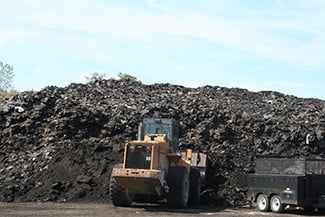Recycling once was uncommon in the roofing industry. Now it is increasing as an ecofriendly and economically wise method to dispose of and reuse material from old concrete and asphalt-shingled roofs.
 Traditionally, the industry's "green practice" involved overlaying an existing roof with another layer of shingles, but this method only delayed the inevitable disposal. These days, many roofing professionals have shingle material ground up for reuse rather than sending it to landfills. This material can be used to improve the quality of roadway pavement.
Traditionally, the industry's "green practice" involved overlaying an existing roof with another layer of shingles, but this method only delayed the inevitable disposal. These days, many roofing professionals have shingle material ground up for reuse rather than sending it to landfills. This material can be used to improve the quality of roadway pavement.
A typical roof weighs 3 to 4 tons - that's a lot to throw away. Shingle recycling allows home and business owners, as well as roofers, to feel good about the disposal process. Here are three considerations when deciding if shingle recycling is right for you.
Environmentally Friendly Practice
In 1998, the Environmental Protection Agency identified asphalt shingles as a major source of construction debris piling up in landfills, according to a report produced for the Construction Materials Recycling Association.
The CMRA report states that the U.S. generates about 11 million tons of asphalt shingle waste per year. However, this waste can be reused in products such as the hot mix asphalt used for building roads.
When ground up, asphalt shingles are often used as a component of hot-mix asphalt. The CMRA report notes that the amount of energy "associated with disposing" of asphalt shingles in landfill and of "using virgin materials" to make hot mix asphalt (HMA) exceeds the amount necessary to recycle asphalt shingles.
Concrete shingles comprise a smaller percentage of the roofing market, but also occupy too much landfill. Crushed into a gravel-like material, recycled concrete also helps limit the amount of resources that must be mined for roadways and other construction projects.
Useful Products from Repurposed Materials
Aside from reducing the manufacturing costs of producing hot-mix asphalt, recycled asphalt shingles have many economical purposes. Here are some uses:
- Cold patch for pothole repair
- Aggregate for the roadway base over which pavement is laid
- Additive in new shingles
- An ingredient in porous asphalt that allows water to soak into the ground.
Crushed concrete shingles are another useful source of aggregate, which is used under either asphalt or concrete pavement. Due to its compactable nature, this aggregate also works well under stone driveways and paving stones along pathways.
Convenient, Cost-Effective Removal
Depending on local landfill and municipal fees, recycling of asphalt and concrete shingles often is less expensive than disposal. Demand is increasing for these materials primarily due to roadway construction and maintenance. Shingle recycling is available in most major metro areas in the U.S. Some construction companies, such as Wolf Paving, also offer recycling services that roofers can easily access.
Whatever recycler you choose, you typically will not be required to separate shingles, roofing felt and nails. This makes the recycling process safer and more convenient for do-it-yourself roofers and roofing companies.
Concrete and asphalt shingle recycling gives roofing professionals and contractors the opportunity to lead sustainable practices within the roofing industry. It removes worry for customers concerned about the environment. Learn more about how green asphalt solutions play a role in protecting our environment and creating innovative asphalt pavement, base materials and more.
Will you or a roofing professional be removing cement or asphalt shingles from a home or business where material recycling is an option? Contact the experts at Wolf Paving for recommendations and a free estimate.





